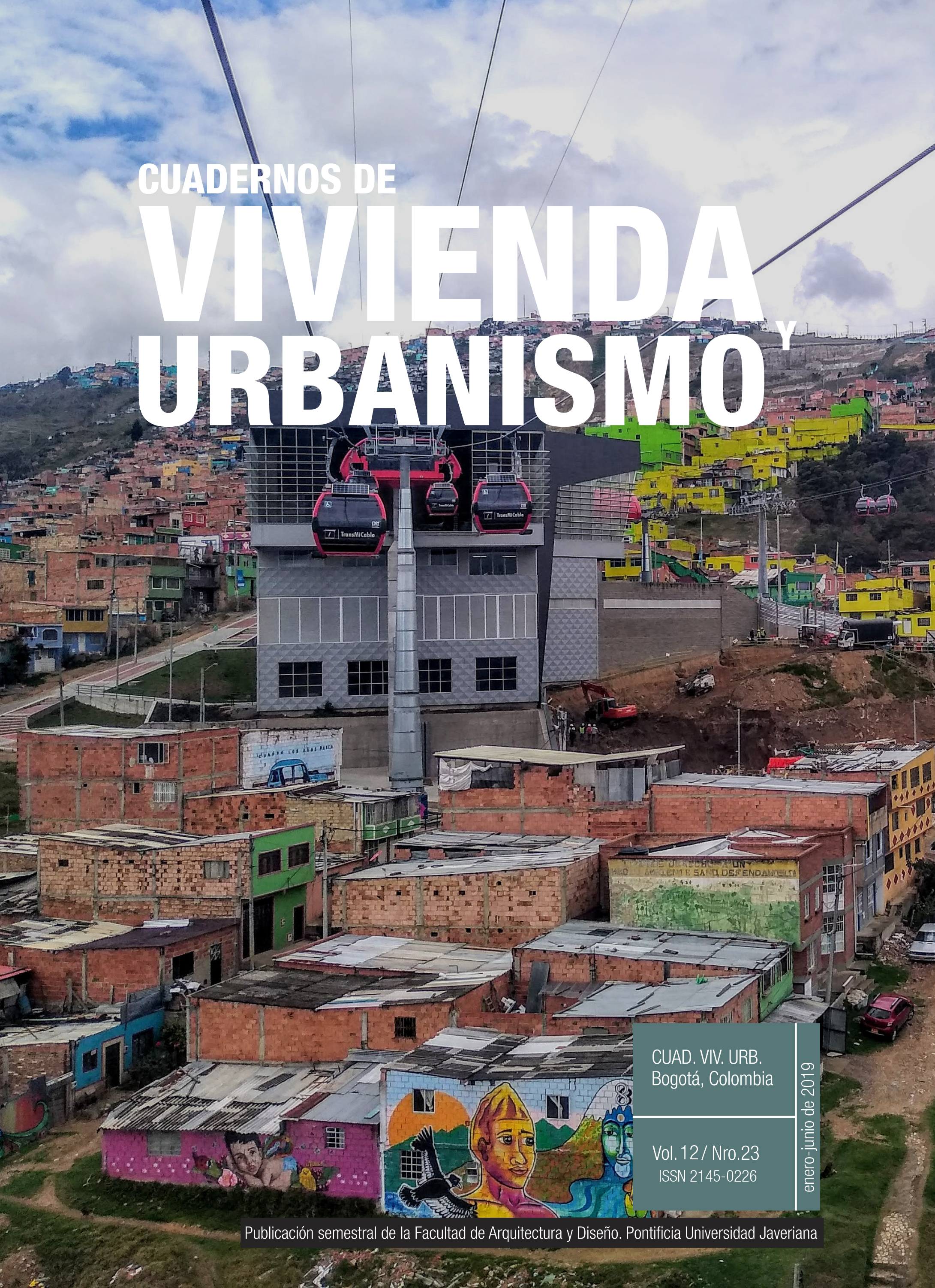Resumo
O acesso a moradia digna é um direito constitucional no Equador, porém, a habitação de interesse social atual não se adequa às necessidades das famílias nem ao clima específico da cidade objeto de estudo.
No artigo são discutidos os resultados de um estudo de exemplos significativos de urbanizações e projetos de Habitação de interesse social das últimas cinco décadas, com o objetivo de avaliar as transformações operadas pelos habitantes ao longo do tempo.
Como resultado, observa-se que embora o padrão físico e social ter melhorado no tempo, há tendências negativas em relação à ocupação do solo, que afetam o ambiente térmico interior das moradias, tanto as transformadas de forma progressiva pela população, quanto os desenhos originais das moradias estatais.
Acosta, G. (2013, 15 de febrero). Distribución Ingresos Ecuador [mensaje en un blog]. Recuperado http://gaston-investigacion.blogspot.com
Acosta, M. (2009). Políticas de vivienda en ecuador desde la década de los 70. Análisis, balance y aprendizajes (tesis de maestría). Recuperado de http://repositorio.flacsoandes.edu.ec/handle/10469/892#.WgOhY2jWw2e
Arcas-Abella, J., Pagès-Ramon, A., y Casals-Tres, M. (2011). El futuro del hábitat: repensando la habitabilidad desde la sostenibilidad. El caso español. Revista INVI, 26(72), 65-9.
Calla, A. (2007). Las políticas de vivienda en Bolivia. Ponencia presentada en el Seminario Taller Internacional La producción social de vivienda y las políticas públicas, La Paz. Recuperado de http://www.derechoshumanosbolivia.org/agenda.php?cod_agenda=AG20091029133302 el 14 de mayo de 2017.
Constitución Política del Ecuador (Const.). (2008). Artículo 30 [sección sexta]. Recuperado de https://www.oas.org/juridico/mla/sp/ecu/sp_ecu-int-text-const.pdf
Espinosa-Cancino, C. F., y Cortés-Fuentes, A. (2015). Confort higro-térmico en vivienda social y la percepción del habitante. Revista INVI, 30(85), 227-242.
Fuster-Farfán, X. (2016). La histórica deuda de las políticas sociales: pertinencia territorial. El caso del programa habitabilidad, Chile. Revista INVI, 31(86), 61-88.
González-Couret, D. (2007). La casa no es una máquina de habitar. Arquitectura y Urbanismo, 28(1), 55–57.
González-Couret, D., y Sánchez-Martínez, O. (2016). Towards a more resilient urban morphology in Havana. Ponencia presentada en PLEA 2016 36th International Conference on Passive and Low Energy Architecture. Cities, Buildings, People: Towards Regenerative Environments, Los Angeles.
Imilan, W., Olivera, P., y Beswick, J. (2016). Acceso a la vivienda en tiempos neoliberales: Un análisis comparativo de los efectos e impactos de la neoliberalización en las ciudades de Santiago, México y Londres. Revista INVI, 31(88), 163-190.
Instituto Nacional de Estadística y Censo (INEC). (2010). Censo de Población y Vivienda. Recuperado de http://www.ecuadorencifras.gob.ec/censo-de-poblacion-y-vivienda/
Moncayo, R. (1986). Situación actual de la vivienda en el Ecuador en relación al Desarrollo Urbano. Conveniencia o no de la creación del Ministerio de Vivienda (trabajo de investigación individual]. Recuperado de repositorio.iaen.edu.ec/bitstream/24000/4218/1/Moncayo%20Cevallos%20Ricardo.pdf.
Naranjo, M. (2008). Ecuador: reseña de los principales programas sociales y lecciones aprendidas, 2000-2006. Santiago de Chile: CEPAL.
Ortiz, E. (1996). Fonhapo. Gestión y desarrollo de un fondo público en apoyo de la producción social de vivienda. México D.F.: Habitat International Coalition.
Pérez-Pérez, A. L. (2011). La calidad del hábitat para la vivienda de interés social. Soluciones desarrolladas entre 2000 y 2007 en Bogotá. Revista INVI, 26(72), 95-126. 2011.
Piña-Hernández, E. H. (2018). Prototipo de vivienda vertical social sustentable, enfoque en resistencia al cambio climático. Revista INVI, 33(92), 213-237.
Salas-Serrano, J. (2002). Latinoamérica: hambre de vivienda. Revista INVI, 17(45), 58-69.
Suárez, M. (2014). Movimientos sociales y buen vivir: ecuatorianos en la lucha por la vivienda en la plataforma de afectados por la hipoteca (PAH). Revista de Antropología Experimental, (14), 71-89.
Staines-Orozco, E. R. (2013). Habitabilidad y eficiencia energética en conjuntos habitacionales de interés social. Ciudad Juárez: Universidad Autónoma de Ciudad Juárez. Recuperado de http://repositorio.uchile.cl/bitstream/handle/2250/118201/habitabilidad-tapia.pdf?sequence=1
Esta revista científica se encuentra registrada bajo la licencia Creative Commons Reconocimiento 4.0 Internacional. Por lo tanto, esta obra se puede reproducir, distribuir y comunicar públicamente en formato digital, siempre que se reconozca el nombre de los autores y a la Pontificia Universidad Javeriana. Se permite citar, adaptar, transformar, autoarchivar, republicar y crear a partir del material, para cualquier finalidad (incluso comercial), siempre que se reconozca adecuadamente la autoría, se proporcione un enlace a la obra original y se indique si se han realizado cambios. La Pontificia Universidad Javeriana no retiene los derechos sobre las obras publicadas y los contenidos son responsabilidad exclusiva de los autores, quienes conservan sus derechos morales, intelectuales, de privacidad y publicidad.
El aval sobre la intervención de la obra (revisión, corrección de estilo, traducción, diagramación) y su posterior divulgación se otorga mediante una licencia de uso y no a través de una cesión de derechos, lo que representa que la revista y la Pontificia Universidad Javeriana se eximen de cualquier responsabilidad que se pueda derivar de una mala práctica ética por parte de los autores. En consecuencia de la protección brindada por la licencia de uso, la revista no se encuentra en la obligación de publicar retractaciones o modificar la información ya publicada, a no ser que la errata surja del proceso de gestión editorial. La publicación de contenidos en esta revista no representa regalías para los contribuyentes.



